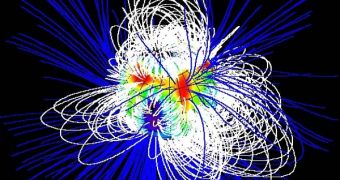Over recent years, astronomers have expressed their amazement at the fluxes of electrons and their antimatter counterparts, the positrons, that were recorded throughout the Milky Way. They tried to explain these occurrences by saying that the positrons could be produced by dark matter, but a new investigation sheds light on the origin of these elementary particles. The actual origin of these elements seems to be in the throes of a dying star, which eliminates all sorts of peculiar radiation it does not normally emit, AlphaGalileo reports.
The new investigation was conducted by an international team of astrophysicists, which included the Bochum junior professor Dr. Julia Becker and the Dortmund physicist professor Dr. Wolfgang Rohde. They reveal that massive stars, with masses at least fifteen times that of our own Sun, are the most likely source for the peculiar emissions of positrons and electrons. In a recent study, published in the latest issue of the respected journal Physical Review Letters, the team explain how their theory is in tune with astronomical observations of these fluxes, carried out over the last few years.
The reason why the origin and characteristics of these small particles could not be detected through direct experimentation is the fact that both types suffer massive interference from cosmic magnetic fields, which alter their paths and orientations, and also cover their “tracks.” While the elusive dark matter has been originally proposed as the source of these elements, “maybe nature can offer a much simpler explanation for the observed particles,” Julia Becker, who is a collaborator on the research team, says. The latter includes members from institutes in Germany, the US and Sweden.
When a massive star dies, it ejects most of its mass, the plasma, in its surroundings, in a massive explosion that may give rise to a supernova, to a black hole, or to a neutron star. This highly accelerated plasma collides with stellar winds, the matter that can be usually found around any star.
“During the collision between fast matter from this final explosion and plasma from previous ejections a shock front is formed, similar to the ones that can be observed in case of supersonic aircrafts. When an aircraft flies faster than the sound, the air surrounding the plane is pushed aside with a speed that exceeds sonic speed. A sonic bang occurs, which spreads in the form of a shock front,” Dortmund astrophysicist Wolfgang Rhode explains.
Dr. Becker concludes that, “This means that [dark matter] does not produce electrons and positrons in the same amount as giant stars and that one has to look for evidence of dark matter elsewhere.”

 14 DAY TRIAL //
14 DAY TRIAL //